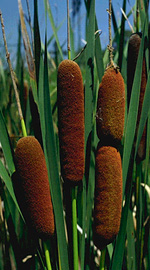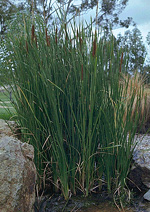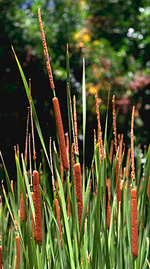 |
This small family comprises a single genus, Typha, found almost throughout the world wherever there is permanent surface water in lakes, deepwater swamps and slow-flowing streams. Two species are found in Australia, almost anywhere suitable habitat occurs.
Characteristic features of the family Typhaceae in Australia include: - tall, robust, erect, emergent herbs with tough, strap-like leaves
- flowers minute, thread-like, densely packed into cylindrical, brown spikes
- fruits small, thread-like with long hairs, dispersing when the spike breaks up
Description
Perennial aquatic herbs rooted in the substrate with their leaves emergent. Perennating by rhizomes. Vegetative reproduction by rhizomes. Stem internodes solid, spongy or pithy. Internal secretions not obvious. Plants glabrous. Leaves distichous, all or mostly basal, or both basal and cauline, sessile. Stipule-like lobes absent. Lamina simple, symmetric, filiform, acicular, subulate or linear; base truncate, rounded, lobed or auriculate; margins entire, ±flat; venation parallel, with the midrib conspicuous or inconspicuous, and the tertiary venation not reticulate; surfaces not punctate; herbaceous, leathery or succulent. Leaf ligule absent. Male and female flowers occurring on the same plant. Inflorescences terminal, consisting of spikes divided into 2 parts, the upper part male and the lower part female. Bracts present or absent. Pollination by wind. Flowers odourless, sessile. Floral disc absent; nectaries absent. Perianth segments absent or vestigial, all free, red, grey, brown or black, without contrasting markings. Fertile stamens 1–7, not clearly correlated with and free of the perianth, free of the ovary and style, fused by their filaments into an open or closed tube, all ±equal. Anthers basifixed, not versatile, opening outwards by longitudinal slits, 2-celled; appendages apical. Ovary superior and stalked. Carpel 1; ovary with 1 locule. Style terminal, single and unbranched. Ovule 1, sessile; placentation apical. Fruit a dry dehiscent or indehiscent follicle, or a cypsela; the perianth on the maturing fruit dry and persistent. Disseminule macro-surface awned, or with a pappus; micro-surface ±smooth, brown, dull. Seed 1 per fruit. Aril absent. Cotyledons 1. Embryo straight.
(Note: this description has been generated from the coded data compiled for the key. Any errors in the key data will be reflected in the descriptions.)
A treatment of the family Typhaceae has been published in:
Flora of Australia 45: 8-11.
Australian genera of Typhaceae (as recognised for the Flora of Australia)
† = some species native, others introduced
†Typha

|
  |

Typha angustifolia (fruiting spikes)
Photo: G.Leiper © G.Leiper

Typha domingensis (habit)
Photo: C.Green © ANBG

Typha sp. (fruiting plant)
Photo: M.Fagg © M.Fagg
|
 |
|